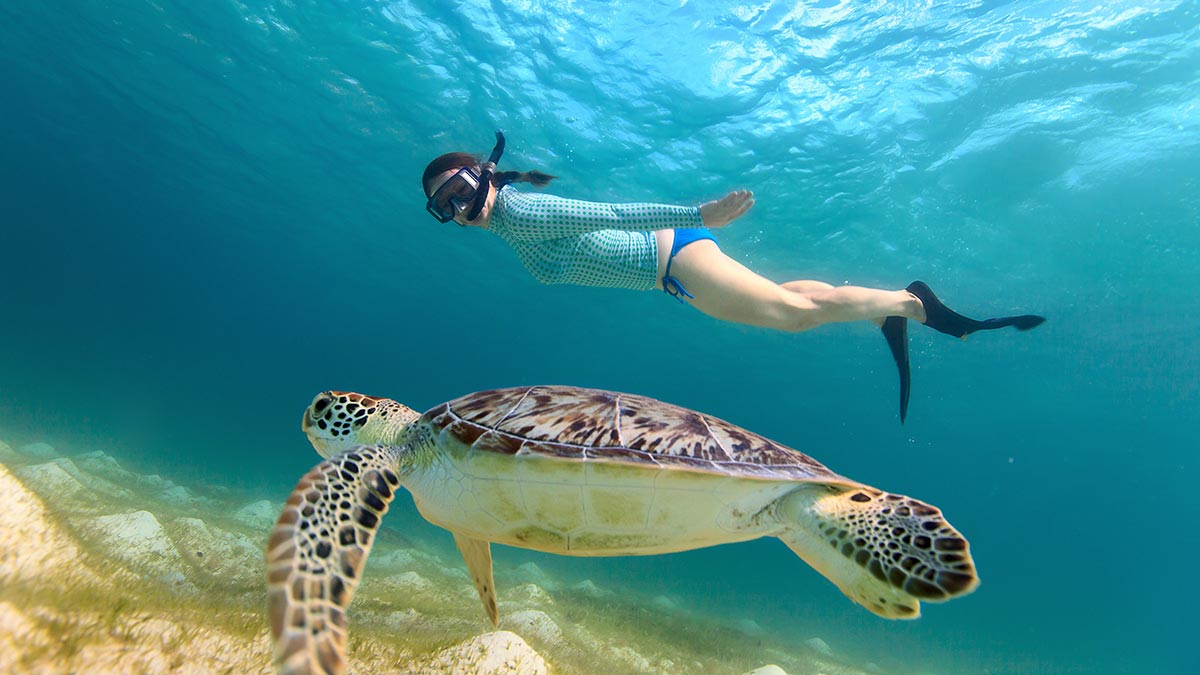Sea turtles have been an important part of ocean ecosystems since the age of the dinosaurs. Humans and turtles have interacted for thousands of years, with drawings of ancient turtles found in early cave paintings. Today, human-turtle interactions are more complicated than ever as humans overload nesting beaches, chase turtles during snorkeling tours, and use large nets to catch our food.
This blog explores why sea turtles are so important and provides sustainability tips on how to protect sea turtles during your travels. By learning more about them and how to be a responsible turtle tourist, you can help ensure these enchanting animals are around for years to come.
Why Are Sea Turtles Important?
Sea turtles are important to the health of ocean ecosystems. All sea turtles are recognized as keystone species, or species that are critical to their environment’s overall health. In addition to ecosystem benefits, sea turtles are lovable animals that motivate people to protect all ocean animals. Turtles are beloved by tourists and bring in money for local communities through turtle-focused activities like snorkeling or beach patrolling.
Keeping Beaches Healthy
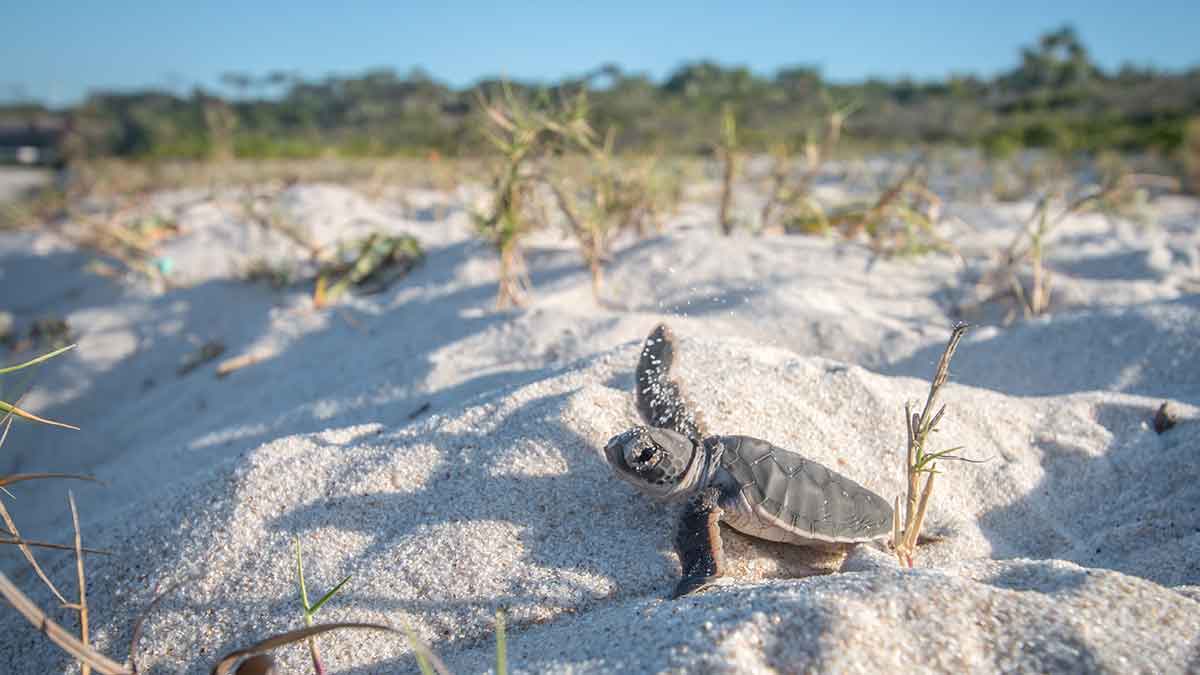
Sea turtles benefit beaches when they lay their eggs, supplying valuable nutrients to microorganisms that live in the sand. Eggshells from hatchlings and unhatched eggs provide nutrients to beach grasses and other plants, which prevent coastal erosion by holding onto the sand. Sea turtle eggs and hatchlings are also an important food source for beach dwellers like seabirds and crabs.
Maintaining Balance in Underwater Ecosystems
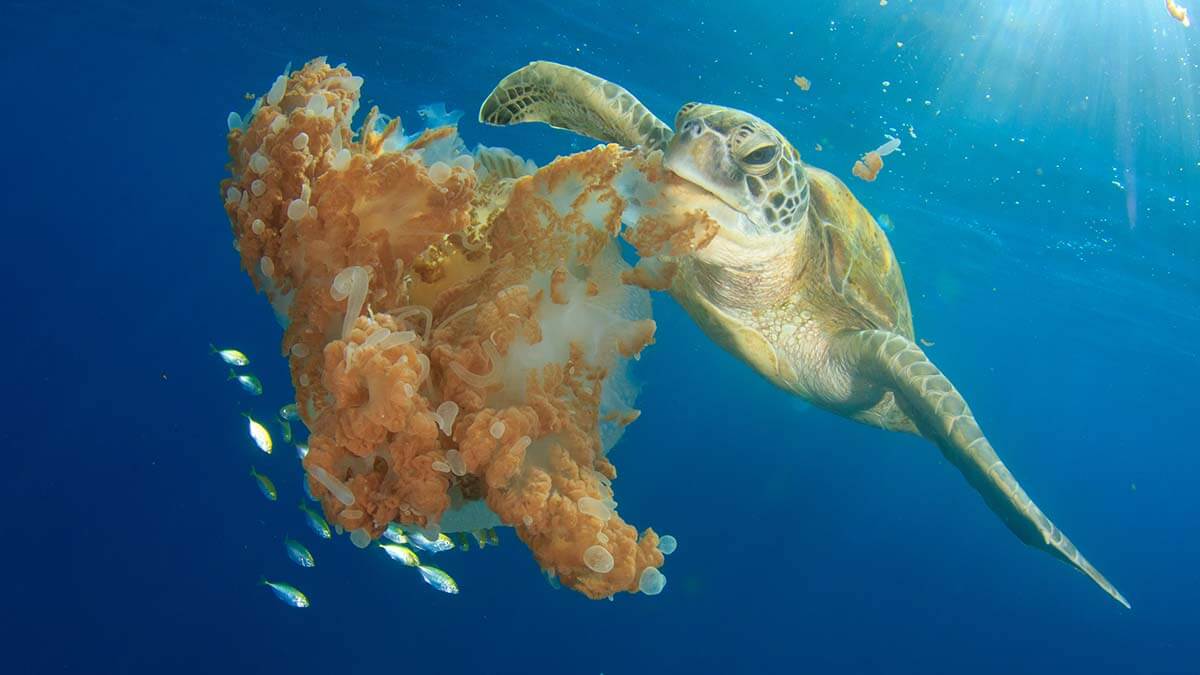
In the water, sea turtles help keep ecosystems healthy by feeding on sponges, which grow aggressively and can prevent coral growth. Most sponges have defense mechanisms that other species do not like, making turtles one of only a few natural predators that can keep them in check. As turtles graze on seagrass, they prevent it from overtaking the area. Overgrown seagrass shades the bottom, obstructs currents, and can decompose rapidly, causing the growth of toxic mold that can kill marine life.
Sea turtles that eat jellyfish control their population, reducing the likelihood of jellyfish swarms, which can kill large numbers of fish and harm people in the water. Jellyfish can also be toxic to the sea floor as they decompose. When turtles eat jellyfish, they prevent their bodies from reaching the sea floor, where they have the potential to suffocate the marine life that lives there. Leatherbacks are particularly important to keeping jellyfish populations in balance, consuming up to 440 pounds, roughly the weight of a full-grown lion, each day.
Turtle Shells: An Ecosystem of Their Own
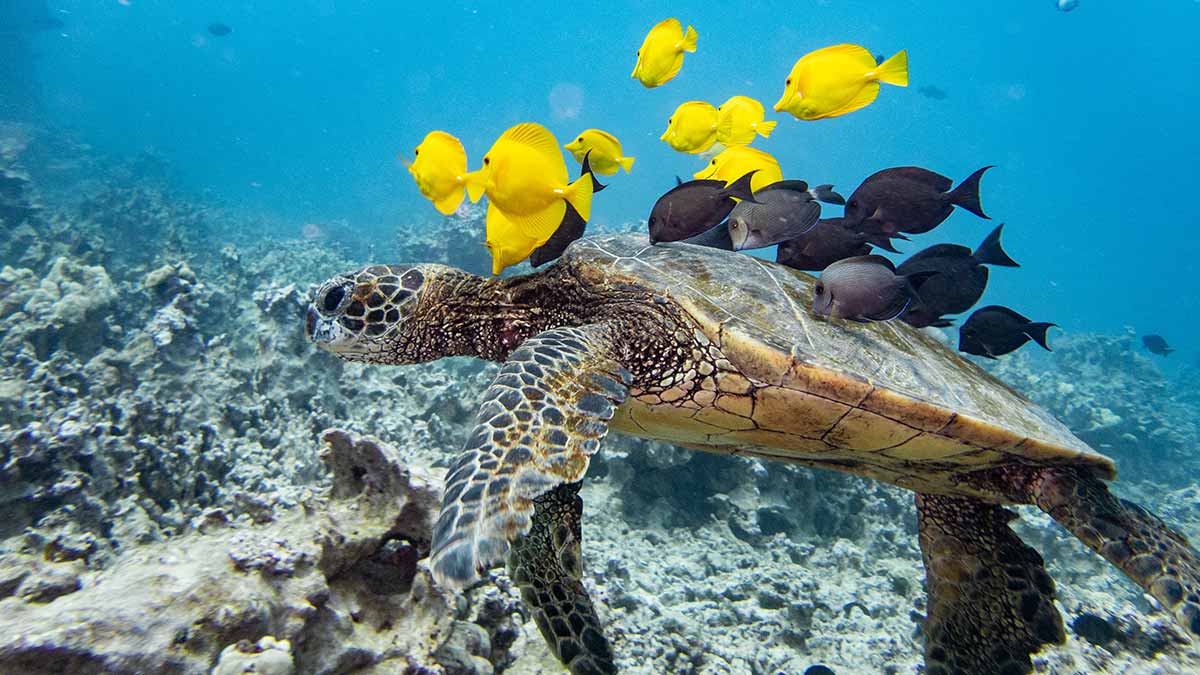
Sea turtles carry algae, barnacles, and other organisms on their shells. As turtles swim through the ocean, fish, shrimp, and other animals eat the organisms that ride on their shells. Without this food source, it would be much harder for reef dwellers to survive.
Tourism and Turtles
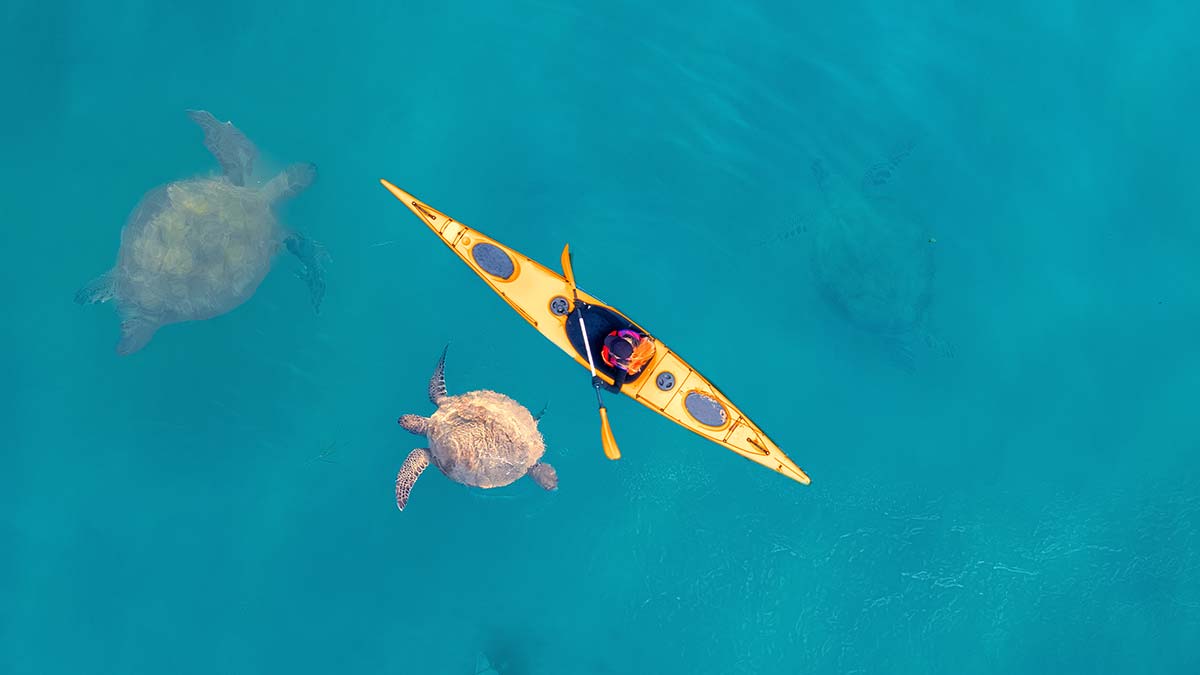
Turtles are a beloved part of the tourism experience in many coastal destinations. They are a highlight in the water on snorkel or dive tours. On land, tourists can sign up for tours that allow them to view nesting females or volunteer with organizations that protect and study sea turtle nests.
Sea turtles are incredibly valuable tourist attractions. In Tortuguero, Costa Rica, over 175,000 tourists take sea-turtle-related tours each year, bringing in $6.7 million dollars per year. . A study by the World Wildlife Fund found that marine turtle tourism was three times as valuable as selling turtle products like meat and shells for consumptive use.
Why are Sea Turtles Endangered?
Six out of the seven sea turtle species are classified as endangered. The only species not listed as endangered is the flatback, which is not classified as endangered due to a lack of data about the population. The International Union for Conservation of Nature (IUCN) classifies olive ridleys, leatherbacks, and loggerheads as vulnerable, green sea turtles as endangered, and Kemp’s ridleys and hawksbills as critically endangered. There are a number of ways that humans threaten sea turtles.
Climate Change
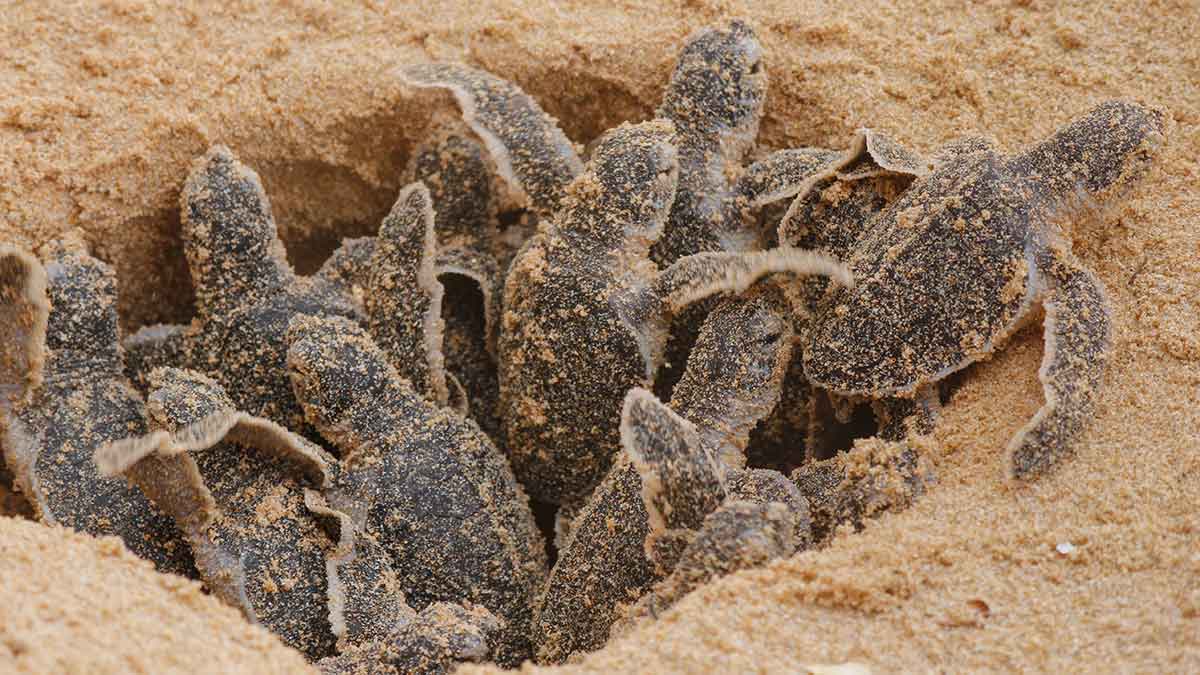
Climate change greatly affects sea turtle populations. Sea turtle eggs require specific temperatures to survive and produce an even balance of male and female hatchlings. Scientists have observed a higher proportion of female hatchlings in recent years due to rising temperatures, which will make it harder for today’s baby turtles to find a mate later in life. Higher temperatures can also cause deformities that prevent hatchlings from making it to the ocean or finding food.
Climate change also results in intense storms, which destroy nesting sites and create strong currents that push baby sea turtles and migrating adults off course. Moreover, rising sea levels threaten nesting beaches and reduce the area of sand that is safe for sea turtle nests.
Rising temperatures may also place sea turtles’ key food sources in jeopardy. Corals and sponges are dying at an alarming rate due to sea temperature warming events that destroy reefs. Warming seas may become too hot for small fish and crustaceans, causing them to migrate or die off, leaving turtles without a reliable source of food.
Fishing and Bycatch
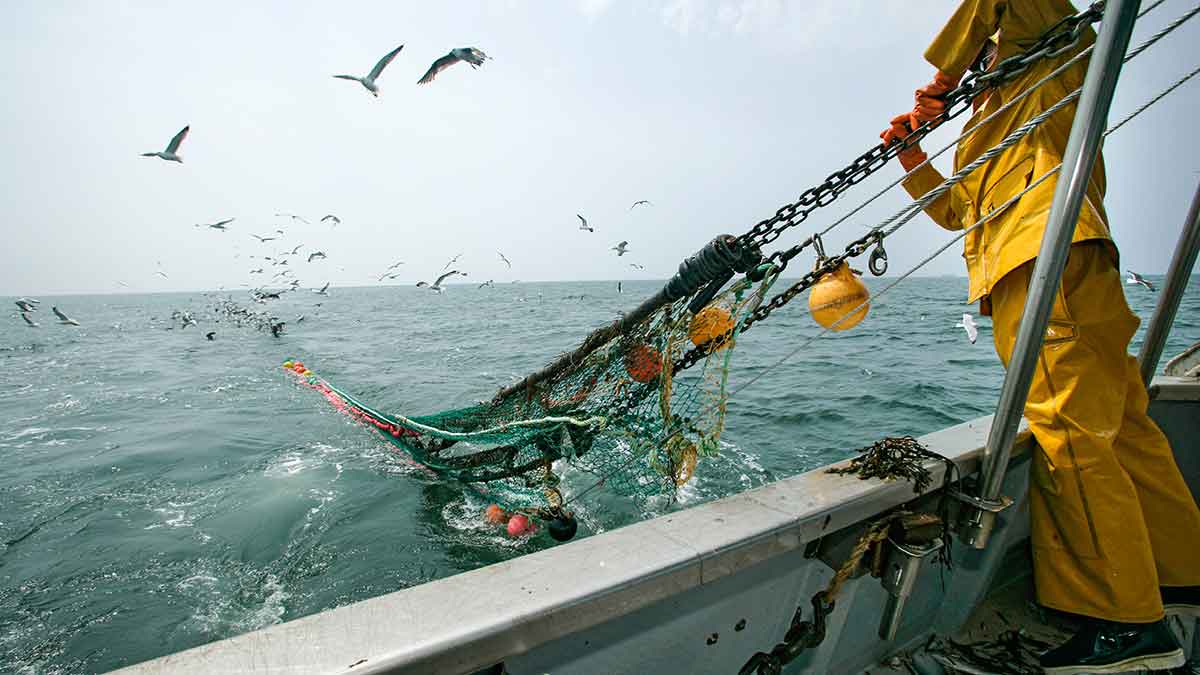
Sea turtles are vulnerable to commercial fishing practices. They often become bycatch or non-target species that get caught in fishing lines and nets. It is estimated that 250,000 sea turtles die as bycatch each year.
Commercial fishermen usually use two tactics to catch large amounts of fish: trawling and longline fishing. Trawling is a practice where fishermen drop weighted nets to the bottom of the sea, dragging them along the ocean floor. When resting sea turtles become entangled in trawl nets, they are unable to come up for air when they need to breathe. Long line fishing is when fishermen bait hooks on fishing lines that can stretch for hundreds of yards. Turtles can mistakenly bite or swallow a longline hook, which can trap them underwater or cause fatal stomach injuries.
Even recreational fishing can pose a threat to sea turtles, especially hatchlings. Hatchlings are more likely to bite an individual hook, quickly swallowing it as they are pulled to the surface. Fishermen often do not know where to send a sea turtle injured by their hooks, resulting in a higher likelihood of death after being caught.
Pollution
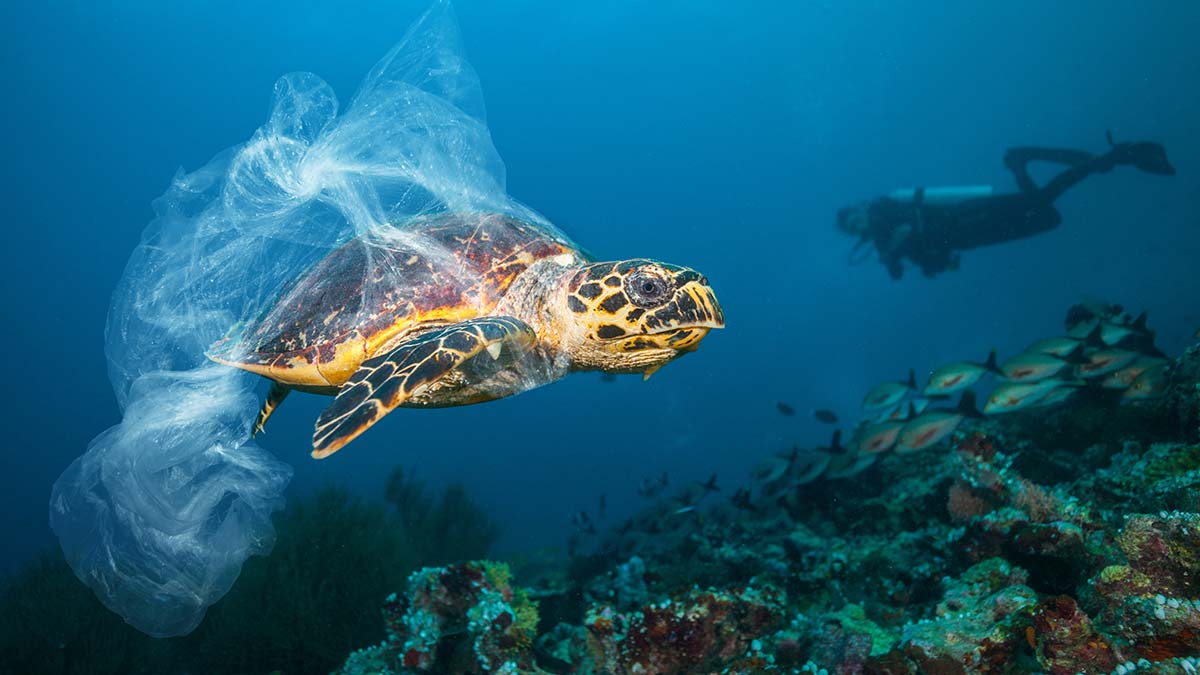
Pollution also negatively impacts sea turtles. Both chemical and physical pollution pose a threat to turtles, with plastics becoming a major threat to their survival.
When untreated waste, toxic metals, and agricultural runoff leach into the ocean, they can kill the plant and animal life that sea turtles depend on. Some hotels in coastal areas pump their wastewater into the ocean. This pollution causes harmful algal blooms that kill off sea turtles’ food sources. Chemicals in sunscreen also negatively impact sea turtle habitats by bleaching or killing coral.
Sea turtles are increasingly infected by Fibropapillomatosis, a disease that causes tumors that can impair their vital functions. While scientists haven’t pinpointed the exact cause of the disease, research suggests that human-induced changes in their habitats, such as climate change and pollution, may contribute to its prevalence.
In addition to chemical pollution, plastic trash is running into the ocean at high rates, with entire areas of the ocean, like the Great Pacific Garbage Patch, covered in litter. Each year, 11 million metric tons of garbage enter the ocean. That is equal to dumping one garbage truck’s worth of trash into the ocean every minute for a year. Sea turtles often mistake plastic bags for jellyfish. Their bodies cannot naturally break down the plastic, which can choke them or become stuck in their stomach, slowly starving them.
Stray fishing nets, made of plastic, look like seaweed, and turtles ingest them with the same deadly effect. A study by the WWF found that 52% of all marine turtles have eaten plastic particles in their lifetime. Turtles also get entangled in plastic, fabric, or other materials that are discarded into the ocean, causing them to drown.
Human Disturbance
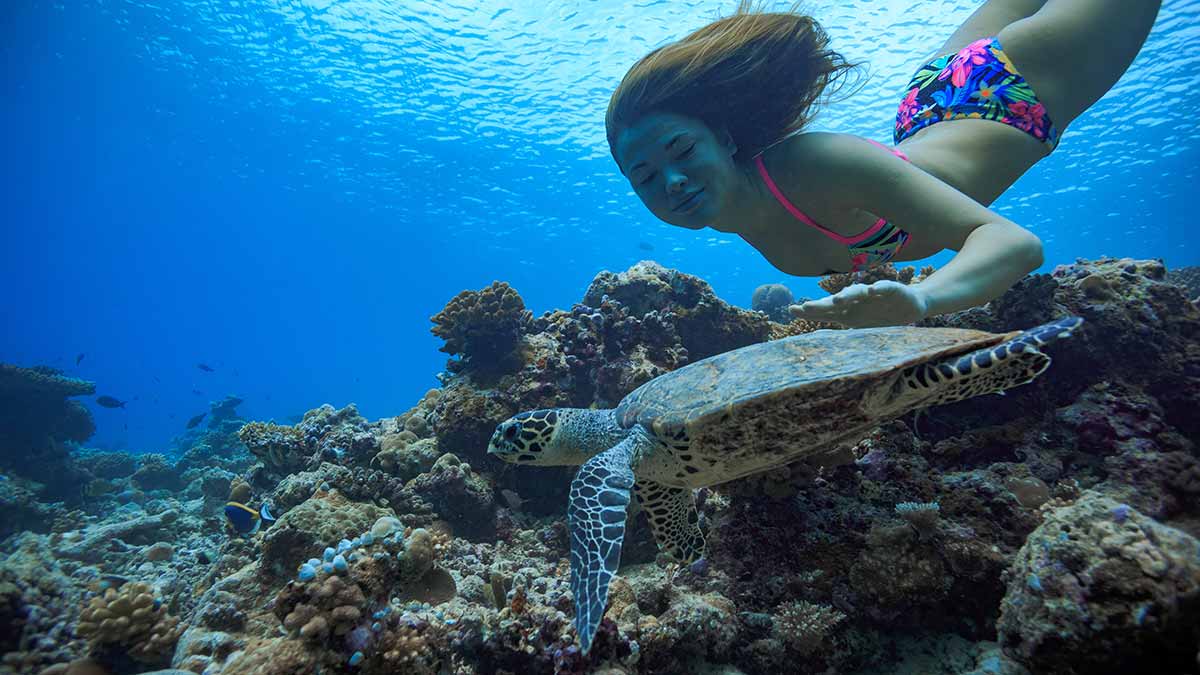
Sea turtles are extremely vulnerable to human disturbances from boats or curious swimmers, snorkelers, and divers. Boats pose the greatest danger to sea turtles, with vessel strike injuries causing 30% of sea turtle strandings in Florida.
In the water, people can disrupt turtles’ natural feeding and resting behavior by approaching them too closely or attempting to touch or ride them. This negatively impacts turtles that live or forage near popular recreational spots, causing them to expend more energy than normal to eat less food. A lack of proper nutrition slows these turtles down, making them a target for predators or, eventually, leading them to drown due to exhaustion. On land, tourists can disrupt turtles’ nesting or basking behavior when they set up loungers on the beach. The more loungers there are, the less space there is for turtles to build nests or warm their bodies in the sun.
Consumption of Turtle Meat, Eggs, or Souvenirs
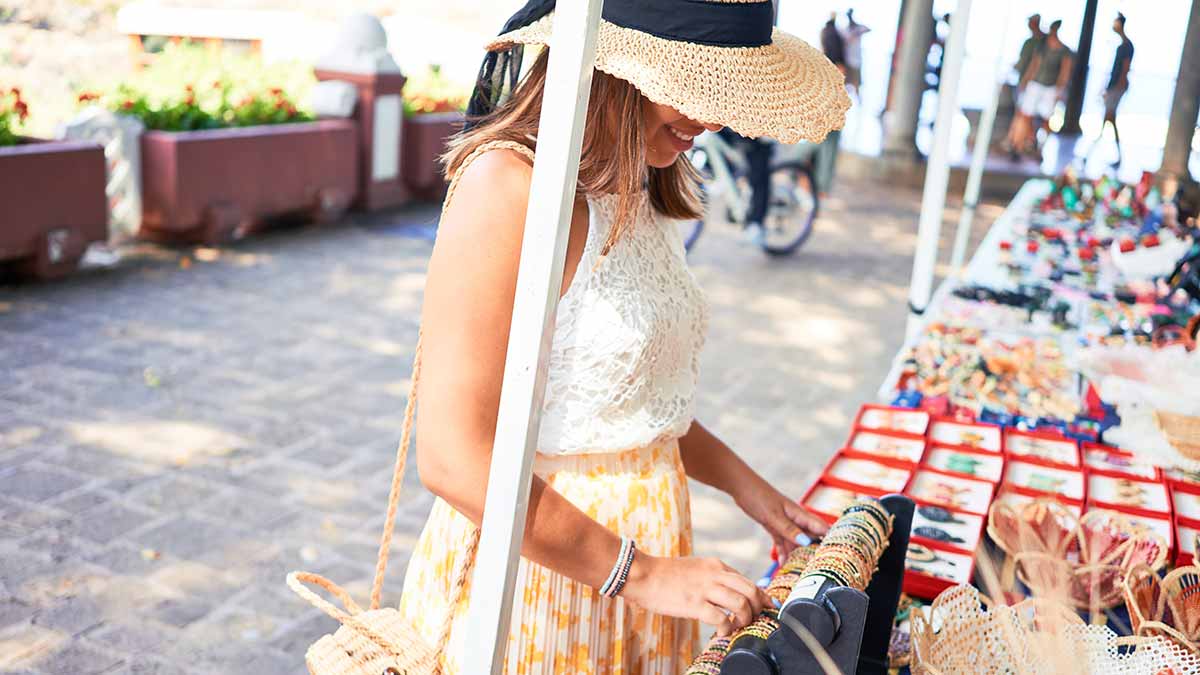
Sea turtles are sometimes harvested for their eggs, meat, and shells. Turtle eggs and meat are considered a delicacy in many countries, and shells are used for cultural ceremonies. Artisans use hawksbill turtle shells to make handicrafts like jewelry that is sold to unsuspecting tourists today, contributing to the killing of countless turtles.
It is important to note that sea turtle meat is culturally significant in some areas, and not all turtle harvesting is bad. In fact, it can be beneficial in certain cases. In areas where large mass nesting events take place, harvesting helps reduce the number of broken eggs that create a breeding ground for harmful bacteria in the soil. With collaborative management between scientists, governments, conservation groups, and local communities, each destination can establish the right balance between turtle protection and cultural preservation.
Coastal Tourism Development
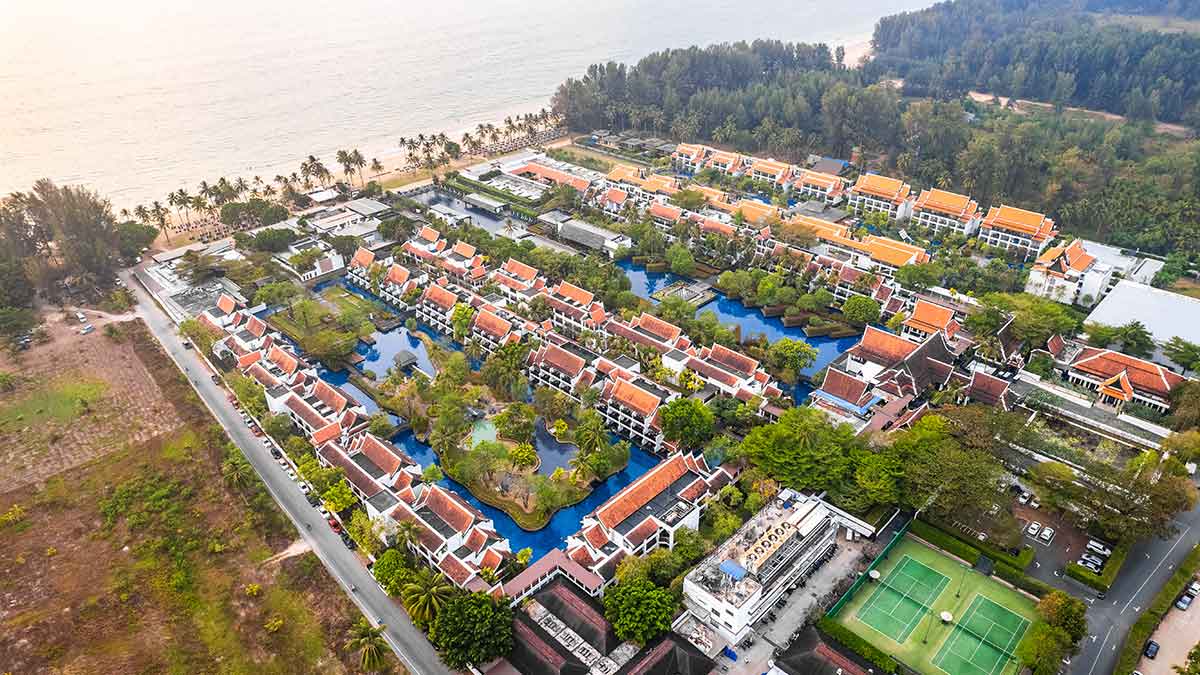
Coastal tourism development also threatens sea turtle species as beaches are cleared to construct hotels. Hotels built on nesting beaches reduce the area where turtles can lay their nests and obstacles like beach loungers disrupt nesting females. Bright white lights can scare away nesting females or confuse hatchlings, causing them to run away from the water and toward the light To manage this disruption, local government officials in Bahia, Brazil, require beach equipment to be placed at a minimum distance from turtle nesting areas and closed off certain sections during nesting season.
In some areas, beaches and nearshore areas are dramatically altered to cater to tourists’ desire for a “pristine” beach. Sand from offshore areas is pumped onto the beach, sometimes burying active turtle nests so deeply that hatchlings are unable to dig themselves out. In destinations like the Maldives, resorts clear seagrass beds so tourists have a sandy spot to swim. This takes away valuable habitat for countless species and removes a key food source for green sea turtles. Thanks to conservation efforts, a quarter of luxury resorts in the area have committed to protecting seagrass beds.
Cruise ships also damage turtles’ habitat. If their enormous anchors hit a reef, they can destroy hundreds of years of coral growth in seconds. When coral is destroyed, turtles that rely on reef species for food and underwater shelter lose a significant portion of their habitat. Reefs can take centuries to regrow, so this damage cannot be remediated in the affected turtles’ lifetimes.
How You Can Protect Sea Turtles When You Travel
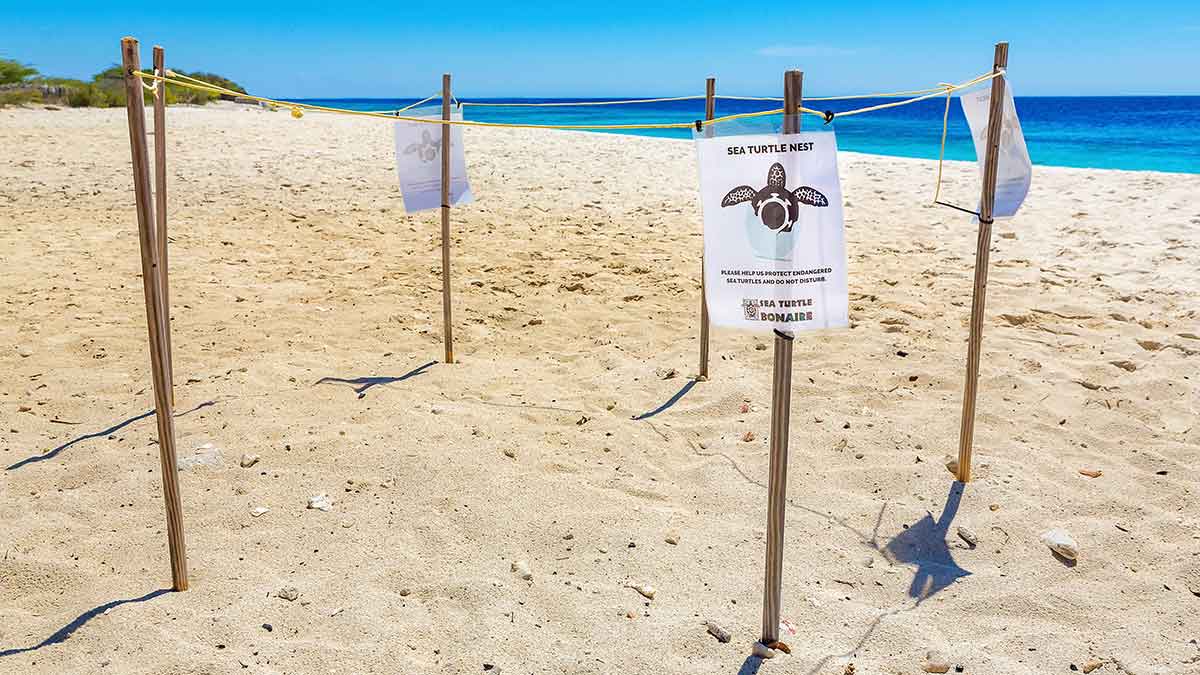
Being a responsible turtle tourist is as simple as respecting turtles’ space, researching to find turtle-friendly tourism businesses, and reporting injured or nesting turtles to authorities. Check out our Responsible Turtle Tourist Checklist below to learn all the ways that you can travel and help save the turtles.
- Don’t litter! Keep your trash with you and make sure that it is disposed of properly to prevent it from traveling into the ocean.
- Reduce your use of single-use plastics to avoid contributing to plastic pollution. Even if you throw your trash away, it could end up in the sea. If a trash can is full, hold onto your trash until you can find a container with less risk of blowing into the water.
- Leave your pets at home. While a day at the beach with Fido might sound nice, your furry friend could disturb nesting turtles or dig up existing nests.
- Stay at beach hotels with wastewater hookups. Some hotels use septic tanks near the ocean which make it more likely that human waste will leak into the water. Do your homework to find a turtle-friendly place to stay.
- Support seagrass and coral reef restoration efforts by staying at hotels involved in these projects or by donating to local restoration projects.
- Keep your distance from turtles on the beach and in the water. They like their personal space and become stressed when you get too close.
- Report nesting, hatching, or injured turtles you see. Check to see if your destination has a turtle sighting app, like Trinidad and Tobago’s TURT app, where you can easily report the location of turtles you see.
- Keep the beach obstacle-free by only packing the supplies you need. Check for turtle tracks or marked nests before you set your chairs in the sand, remove umbrellas at night, and always remember to watch where you step on known nesting beaches.
- Limit the use of artificial or white light on beaches at night. White light can scare away nesting sea turtles or confuse hatchlings, causing them to run away from the water and toward your light. Always try to support beachfront hotels and businesses that use turtle-friendly lights. In some places, using white lights at night is illegal. Check out local laws to make sure that you comply.
- Do not buy or consume turtle products. Do your part to ensure the handicrafts you buy are not made of tortoiseshell. While it may be tempting to try turtle meat, it is most often produced through poaching. Avoid supporting poachers by choosing to order another dish.
- Reduce your carbon footprint when you travel. Our carbon footprint calculator makes it easy to calculate and offset your emissions. To learn more about how to reduce your footprint, check out our top tips for climate-friendly travel.
- Skip toxic chemical sunscreens in favor of reef-safe products to protect coral reefs. Alternatively, wear clothing with UV protection to eliminate the need for sunscreen.
- Support tourism businesses that contribute to turtle conservation initiatives. Look for businesses with turtle-friendly lighting, sea turtle reserves, or programs that help tourists donate to sea turtle conservation. A great example of this is Playa Viva in Mexico, a hotel that has a sea turtle conservation area on-site.
- Volunteer with verified organizations to help with turtle conservation when you travel. It is important to do your research to ensure that you choose a reputable volunteer organization. Look for companies that partner with larger, reputable organizations, government entities, or scientific research programs, rather than companies that simply advertise volunteer work without any details. A few red flags to look for when choosing a volunteer organization include programs that allow petting of sea turtles, programs that do not tell you what the cost of your experience supports, and programs that take in sea turtle hatchlings without a long-term release plan. Read more about how to find a responsible volunteer opportunity here.
- Learn more about how you can contribute to turtle conservation by taking advantage of free resources like: U.S. Fish and Wildlife Service Information, NOAA Sea Turtle Conservation, University of Florida.
Free Sustainable Travel Tips List

